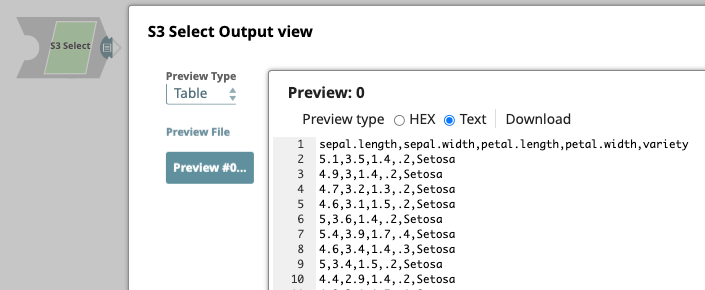S3 Select
Overview
You can use this Snap to execute a SELECT query on CSV, JSON, and Parquet S3 objects, which may be compressed in GZIP or BZIP2 format.
-
AWS S3 does not define any folder object and the '/' characters are part of the S3 object key names.
-
This Snap captures metadata and lineage information from the input document.

Read-type Snap
Works in Ultra Tasks
Prerequisites
- A valid S3 account with the required permissions.
Limitations
The conditional fields Field Delimiter, Record Delimiter, Quote Character, Quote Escape Character, and File Header Info associated with the CSV Data Format are not displayed for non-CSV data formats. They are also not displayed if the Data Format field is expression-enabled. If you plan to make the Data Format expression-enabled to process the CSV-related properties, follow these steps:
-
Set CSV as the Data Format.
-
Configure the conditional fields.
-
Enable the expression.
You must follow these steps because the values of these properties are used during the execution only if the value of the Data Format is set to CSV, even when the associated conditional fields are not displayed.
Snap views
| View | Description | Examples of upstream and downstream Snaps |
|---|---|---|
| Input | An upstream Snap is optional. Any document with key-value pairs to evaluate expression properties. | |
| Output | An example of the output binary data is as following: |
|
| Error |
Error handling is a generic way to handle errors without losing data or failing the Snap execution. You can handle the errors that the Snap might encounter when running the pipeline by choosing one of the following options from the When errors occur list under the Views tab. The available options are:
Learn more about Error handling in Pipelines. |
|
Snap settings
- Expression icon (
): Allows using pipeline parameters to set field values dynamically (if enabled). SnapLogic Expressions are not supported. If disabled, you can provide a static value.
- SnapGPT (
): Generates SnapLogic Expressions based on natural language using SnapGPT. Learn more.
- Suggestion icon (
): Populates a list of values dynamically based on your Snap configuration. You can select only one attribute at a time using the icon. Type into the field if it supports a comma-separated list of values.
- Upload
 : Uploads files. Learn more.
: Uploads files. Learn more.
| Field / Field set | Type | Description |
|---|---|---|
| Label | String | Required. Specify a unique name for the Snap. Modify this to be more appropriate, especially if more than one of the same Snaps is in the pipeline. Default value: S3 Select Example: Select Invoices from Q4 2018 |
| Bucket | String/Expression/ Suggestion | Required. Specify the S3 bucket name where S3 objects are located. Warning: Do not add S3:/// before bucket name, because
the Snap can fail. Note:
Note: If you enter an incorrect region name, but the bucket name is valid, the AWS S3 service may successfully access the bucket without any errors. Default value: None. Examples:
|
| Object Key | String/Expression/ Suggestion | Required. Specify the S3 object key name, which may include one or more forward-slash ('/') characters. Note: The forward-slash
character is part of the S3 object key name and there is no folder object defined
in AWS S3. The maximum length of the suggested list is 1,000. Default value: None. Examples:
|
| Select Query | String/Expression |
Enter a SELECT query to be executed on the S3 object. For a detailed description on using the SELECT command, refer to the Amazon documentation:SELECT command - Amazon Simple Storage Service Default value: None. Example: select * from S3Object |
| Input Data Format | ||
| Compression Type | Dropdown list/Expression | Required. Select one of the following compression types:
NONE, GZIP, or BZIP2. Note: The Amazon S3 Select service does
not support Compression Type BZIP2 or GZIP for the Parquet input
data type. Default value: None. Example: GZIP |
| Data format | Dropdown list/Expression |
Required. Select one of the data formats for the input data: CSV, JSON or Parquet. Default value: CSV Example: JSON |
| Field Delimiter | String/Expression | Appears when you select CSVfor Data Format. Enter the field delimiter character used in the input data. Default value:
Example:
|
| Record Delimiter | String/Expression/ Suggestion | Appears when you select CSVfor Data Format. Enter the record delimiter used in the input data. Default value: LF (new line) Example: CRLF |
| Quote Character | String/Expression | Appears when you select CSVfor Data Format. Enter the quote character used in the input data. Default value:
Example:
|
| Quote Escape Character | String/Expression | Appears when you select CSVfor Data Format. Enter the
escape character used to escape quote characters inside the values, where values
are wrapped around quote characters in the input data. Note that some CSV file
uses double quote character to escape double quotes inside values. For example,
Default value:
Example:
|
| File Header Info | Dropdown list/Expression | Appears when you select CSVfor Data Format. Specify whether to use the header information in the SELECT query. Default value: USE Example:
|
| Show Advanced Properties | Checkbox | Select this checkbox to display the advanced properties. Deselect this checkbox to hide the properties. Default status: Deselected |
| Maximum Retries | Integer/Expression |
Appears when you select the Show Advanced Properties checkbox. Required. Specify the maximum number of retry attempts to perform in case of a temporary network loss. Default value: 3 Example: 2 |
| Snap execution | Dropdown list |
Choose one of the three modes in
which the Snap executes. Available options are:
Default value: Execute only Example: Validate & Execute |


